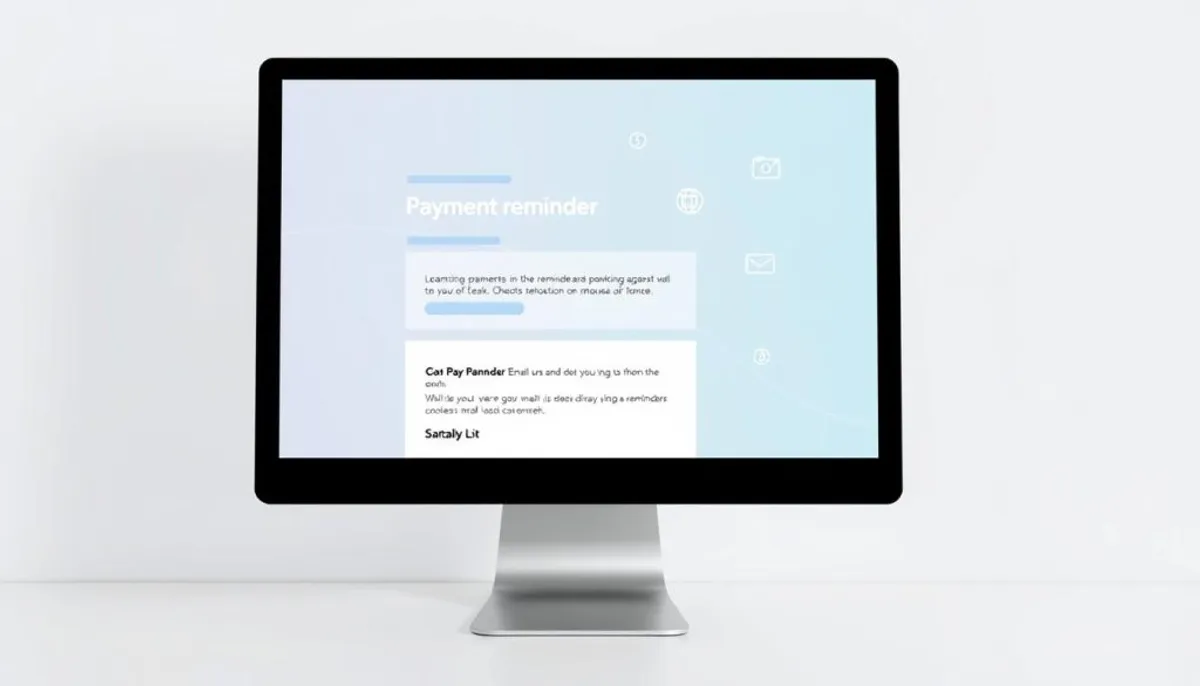Late payments are a significant challenge for businesses across all sectors. An astonishing 87% of companies report that their invoices are paid after the due date. This widespread issue can severely impact cash flow and hinder growth. Fortunately, a well-crafted email template payment reminder can significantly alleviate this problem.
Payment reminders serve more than just as a means to collect overdue payments. They are crucial for maintaining professional relationships and ensuring the smooth operation of your business. By adopting the right approach, you can potentially reduce late payments by up to 40% and significantly enhance your cash flow.

Enter ti3, a pioneering SaaS platform designed to streamline the management of overdue accounts. This innovative solution automates the payment reminder process, enabling you to receive payments faster without the need for extensive follow-ups. Businesses utilizing ti3 have witnessed a substantial reduction in collection time for overdue invoices, cutting it in half.
In this comprehensive guide, we will explore effective strategies for crafting payment reminders that yield tangible results. We will discuss the importance of timing your reminders and maintaining a friendly yet firm tone. Whether you are a freelancer owed $4,000 or a large corporation facing consistent delays, these strategies will aid in securing timely payments and ensuring the continued success of your business.
Late payments are a major threat to businesses, disrupting cash flow and hindering growth. The impact on accounts receivable and financial health is profound. In the UK, creditors’ voluntary liquidations rose by 51% in 2021. This resulted in 19,604 companies liquidating to settle outstanding debts.
Late payments severely impede cash flow optimization efforts. Small businesses are most vulnerable, as losing a single payment can threaten their survival. Thus, timely invoicing and diligent follow-ups are crucial for maintaining financial stability.
Payment delays affect businesses worldwide, regardless of size. Invoices are considered overdue 14 days past the due date, requiring immediate follow-up. Experts advise sending payment reminders on the due date and following up within 1-2 days if payment is not received.
Several factors contribute to payment delays:
Implementing effective accounts receivable management and cash flow optimization strategies, such as ti3’s automated payment reminder solution, can help businesses overcome these challenges and ensure timely payments.
Effective customer communication is crucial for maintaining a healthy cash flow. Proactive payment follow-up can significantly enhance timely payments. Studies reveal that 82% of business failures stem from cash flow issues, underscoring the importance of timely payments.
Adopting a robust payment reminder system can revolutionize your collection process. Businesses that send reminders 3-7 days before due dates experience a 40% increase in timely payments. This proactive strategy not only boosts cash flow but also strengthens customer relationships.
The tone of your reminders is pivotal. Companies employing a friendly tone in payment communications witness a 15% rise in customer satisfaction scores. Incorporating humor can expedite overdue payments by 25% compared to formal language.
Automation is transformative in payment follow-up. Ti3’s automated reminder system eliminates the uncertainty of when and how to communicate with clients about payments. It ensures consistent, effective follow-ups, allowing you to concentrate on your core business activities.
Clear communication about payment terms, including late fees, can increase compliance by up to 35%. By utilizing these insights and tools like ti3, you can substantially enhance your payment collection process. This will help maintain positive client relationships.
Creating effective payment reminder emails is vital for maintaining a healthy cash flow. With 29% of invoices paid late, businesses must optimize their reminders. Let’s examine the key elements that make payment reminder emails successful.
Your subject line is the first thing recipients see. It should be clear and concise. Include the invoice number and due date to capture attention. For instance, “Invoice #1234 Due on 05/15/2023” is direct and informative.
The email body should be concise yet comprehensive. Begin with a polite greeting and a reminder of the outstanding payment. Include the invoice details, total amount due, and payment methods. A well-structured body can increase the chances of prompt payment by 30%.
A clear call-to-action (CTA) is essential. Use buttons or links that direct clients to pay immediately. CTAs like “Pay Now” or “View Invoice” can boost response rates by 40%. Ensure these are prominently displayed and easy to click, even on mobile devices.
Always include complete payment information. List accepted payment methods, account details for bank transfers, and links to online payment portals. Offering multiple payment options can increase payment rates by up to 30%.
Implementing these components in your email templates can significantly improve your dunning process. Email automation tools like ti3 can streamline this process, reducing the time spent on crafting reminders by 50% and allowing for quicker follow-ups on overdue payments.
Understanding the timing of payment reminders is essential for effective accounts management. The right timing can significantly increase the likelihood of timely payments. Studies indicate that businesses that implement timely reminders experience a notable rise in on-time payments, leading to enhanced financial stability.
Implementing a strategic timing approach involves sending the initial email a few days before the payment is due. This serves as a gentle reminder, setting clear payment expectations. On the actual due date, a second reminder can prompt immediate action from clients.
For payments that are past due, a systematic follow-up schedule is crucial. Sending reminders at intervals of one, 15, 30, 45, 60, and 90 days past due is an effective strategy. This consistent communication keeps the payment in the client’s mind without being overly aggressive.
Interestingly, text message reminders have a remarkable 98% open rate, compared to email’s 20-30%. Integrating both channels into your payment reminder strategy can lead to better outcomes. It’s important to maintain a clear and friendly tone in all communications to enhance customer responsiveness and improve payment rates.
Implementing effective pre-due date reminder strategies can significantly improve your payment collection process. By sending timely email template payment reminders, businesses can reduce late payments and maintain healthy cash flow.
Sending payment reminders before the due date offers numerous advantages. Studies show that well-timed reminders can reduce late payments by up to 30%. This proactive approach helps clients stay on top of their financial obligations and prevents unintentional oversights.
Clear communication is key when setting payment expectations. Include essential details in your customer communication, such as invoice numbers, due dates, and amounts owed. This transparency helps avoid misunderstandings and disputes later on.
Providing clear payment method instructions can expedite the process. Include electronic payment options in your email template payment reminder to simplify transactions for clients. This approach can significantly reduce paperwork and processing time.
By implementing these pre-due date reminder strategies, businesses can improve their payment collection process and maintain positive customer relationships. Remember, consistent and professional customer communication is key to ensuring timely payments and fostering long-term business success.
Effective payment follow-up is essential for maintaining a healthy cash flow. We will examine templates for various stages of debt collection. This includes gentle reminders and final notices.
Initiate your first reminder 5-7 days post-due date. The tone should be friendly, assuming an oversight:
For invoices 14 days past due, adopt a firmer tone:
Dispatch this 30-45 days after the due date:

Utilizing ti3 for these reminders can save 10 hours monthly on payment follow-ups. Sign up to streamline your debt collection process. This will enhance cash flow by 10-20%.
Effective customer communication and accounts management are pivotal in forging enduring client bonds. Payment reminders hold a significant role in this endeavor. Research indicates that a friendly tone in reminders can significantly bolster client relationships, with approximately 60% of clients valuing courteous over aggressive communication.
In crafting payment reminders, a professional yet amicable tone is paramount. This strategy can elevate client satisfaction by up to 15%. Employ clear, direct language and eschew accusatory or demanding expressions. The objective is to remind, not to estrange.
Payment communications present a chance to fortify client relationships. Personalized templates can elevate response rates to 50%. By adopting a systematic approach to payment communication, you can enhance professional ties, essential in sectors like leadership coaching. In fact, coaches leveraging automated invoicing systems have witnessed a 25% enhancement in cash flow stability.
Ti3’s automated system is crafted with relationship management in mind. It ensures all communications retain a professional and courteous demeanor, facilitating the balance between effective accounts management and positive customer interaction. This methodology can diminish awkward payment discussions by up to 40%, cultivating stronger, enduring client bonds.
Late payments are a significant challenge for businesses, with 87% experiencing delays and 68% facing cash flow issues due to overdue invoices. The ti3 platform offers a groundbreaking solution for managing accounts receivable through email automation.
Ti3 revolutionizes payment collection with automated reminders, issue escalation, and seamless integration. This SaaS solution dramatically reduces invoice processing time by 80% and errors by 66% compared to manual methods. Users have reported a significant reduction in average payment times, from 30+ days to just 14 days.
Integrating ti3 into existing systems is remarkably straightforward. The platform connects with your accounting software, imports customer data, and sets up customized reminder schedules. Minimal training is required, allowing for quick adoption and immediate benefits.
Businesses utilizing ti3 experience notable improvements:
By utilizing ti3’s advanced email automation features, businesses can significantly enhance their accounts receivable processes. This ensures timely payments and promotes healthier cash flow.

Engaging in payment reminders requires businesses to traverse a complex legal terrain. Effective accounts management necessitates a deep understanding of debt collection laws. Approximately 50% of entities must adhere to specific mandates regarding late fee notifications and escalations, contingent upon their geographical location.
Adherence to data protection statutes, such as GDPR in Europe, is paramount when dispatching payment reminder emails. These regulations safeguard customer privacy and protect sensitive data. It is imperative to maintain precise records of all interactions regarding unpaid invoices. This is crucial for dispute resolution and legal compliance.
To circumvent legal complications, enterprises should:
By adhering to these directives, companies can proficiently manage their accounts receivable while respecting legal frameworks. This strategy fosters positive client interactions and minimizes the necessity for conventional debt collection practices.
Assessing the success of your payment reminders is vital for optimizing cash flow and managing accounts receivable. We will examine key metrics and strategies to evaluate and improve your reminder effectiveness.
To gauge the impact of your payment reminders, focus on these critical KPIs:
Analyze client responses to refine your approach. Research indicates that reminders sent two weeks before the due date can expedite payments. Including the invoice as an attachment and using clear subject lines enhance open rates and prompt faster payments.
Implement these strategies to enhance your payment collection process:
By consistently applying these practices and analyzing your KPIs, you can optimize your accounts receivable process and improve cash flow. Remember, effective payment reminders not only help recover revenue but also strengthen customer relationships.
Effective payment reminders are vital for maintaining a healthy cash flow and fostering strong client relationships. Our examination of email template payment reminders has uncovered essential strategies to enhance your accounts receivable process. Given that over 50% of B2B invoices in the U.S. become overdue, it’s evident that follow-ups are indispensable.
Creating concise, timely payment reminders can substantially increase response rates. Emails ranging from 50 to 125 words have demonstrated a 50% response rate. Including specific details such as invoice numbers and payment deadlines minimizes confusion and encourages prompt action. It’s worth noting that 35% of individuals miss bills due to forgetfulness, highlighting the importance of gentle reminders.
ti3 presents a cost-effective, efficient alternative to traditional debt collection methods. By automating payment reminders, businesses can sidestep the drawbacks of manual follow-ups while preserving positive client relationships. With ti3, you can streamline your accounts receivable management, decrease administrative overhead, and concentrate on your core business activities.
In today’s fast-paced business environment, timely payments are crucial for covering operational costs and investing in growth. By adopting these payment reminder strategies and utilizing tools like ti3, you can enhance your cash flow, decrease late payments, and position your business for long-term success.